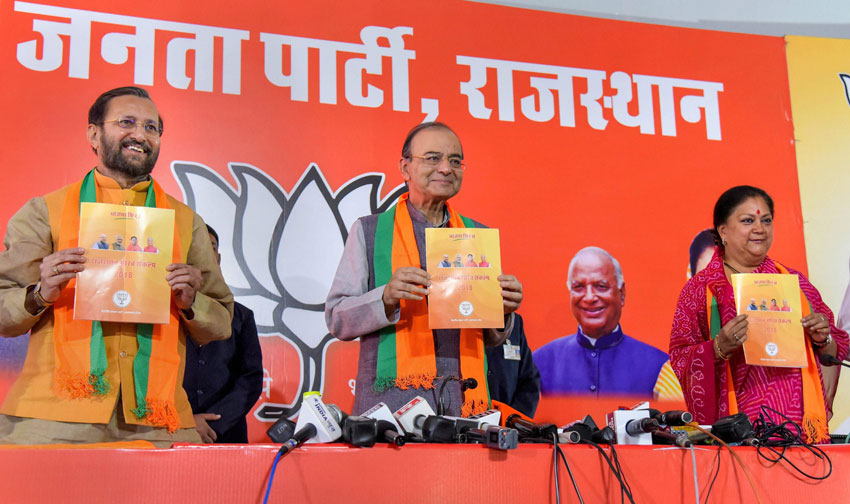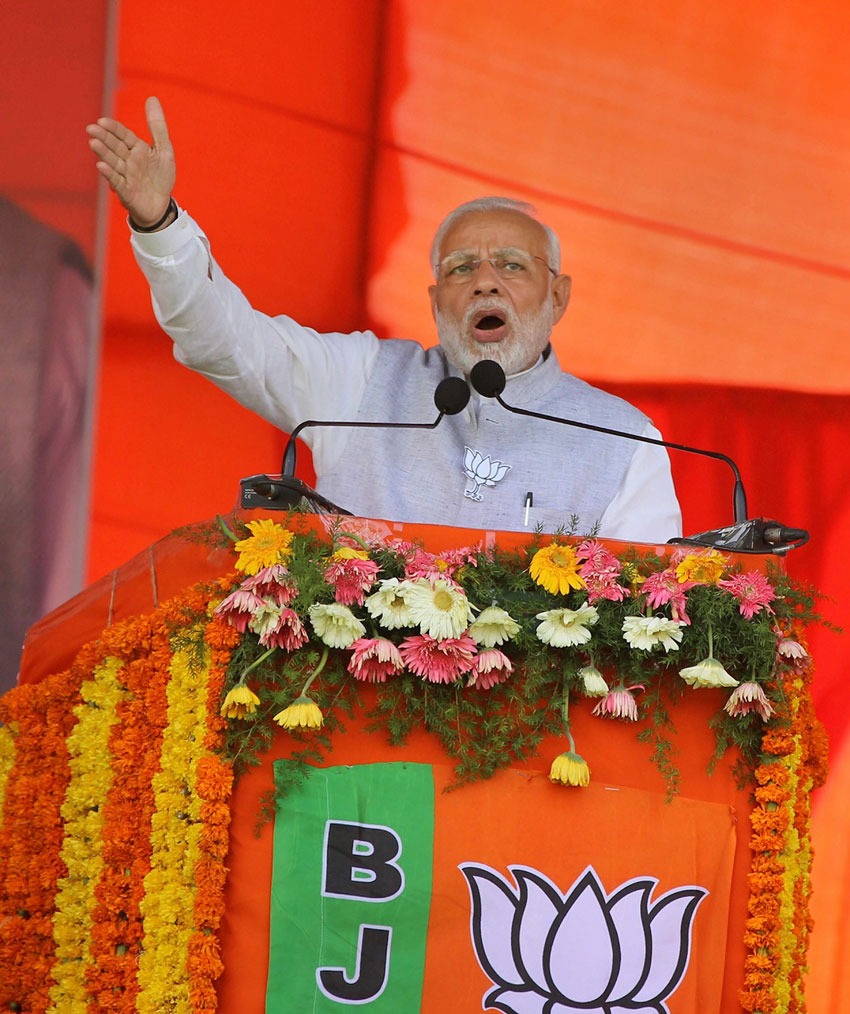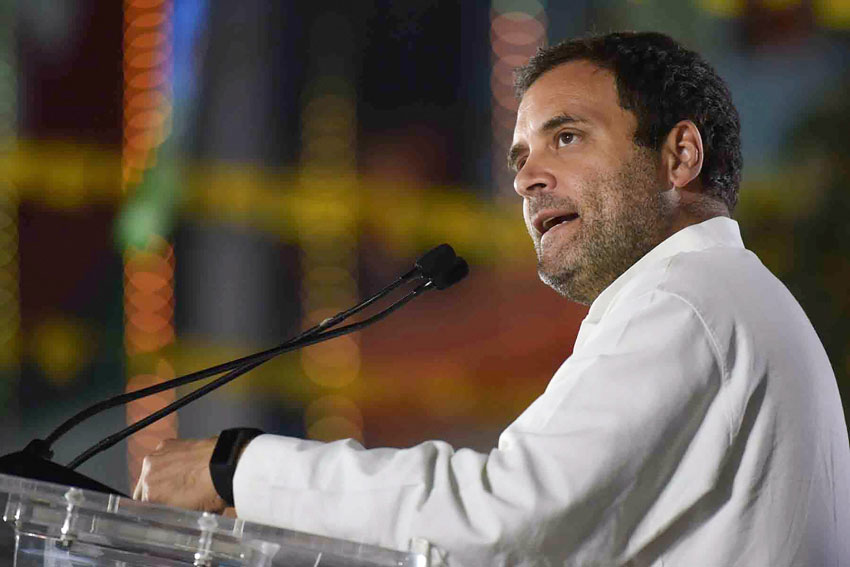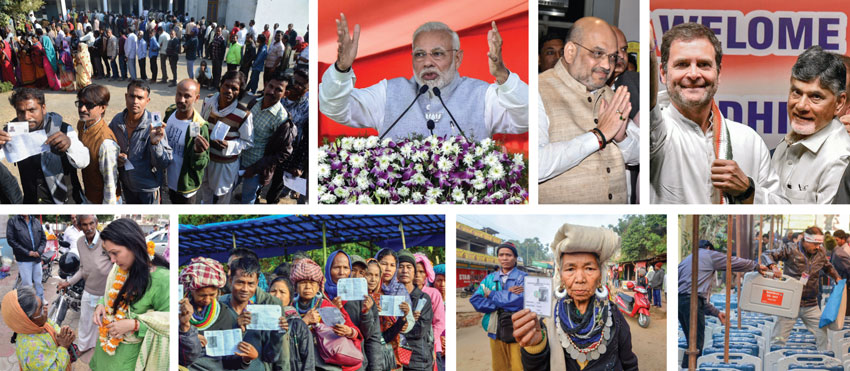State Polls in India: A Precursor To 2019 General Elections?
(Clockwise from left): (TOP): People wait to cast votes in Jabalpur, MP, Nov. 28.; PM Modi in Nizamabad, Telangana, Nov. 27; BJP President Amit Shah in Jodhpur, Nov. 30; Congress president Rahul Gandhi with TDP president N. Chandrababu Naidu (r) in Hyderabad, Nov. 28.;
(BOTTOM): Election officials collect their EVMs in Jabalpur, MP, Nov.27; A Bru tribal woman at Kanhmun, Mizoram, Nov.28; Voters at Kanhmun, Nov.28; and BJP candidate Siddhi Kumari (r) in Bikaner, Rajasthan, Nov. 27. (All photos: Press Trust of India)
The results of the ongoing state assembly elections in Madhya Pradesh, Chhattisgarh, Rajasthan, Telangana and Mizoram are being widely touted as precursors or semi-finals before the country plunges into the April /May 2019 Indian General Elections, writes Priyanka Bhardwaj.
Right now, these states are witnessing the contest to their legislative assemblies that are being keenly contested by primary political parties, the Bharatiya Janata Party (BJP) and the Congress, in Rajasthan, Chhattisgarh and Madhya Pradesh, joined in by regional behemoths, such as the Bahujan Samaj Party (BSP) and the Janata Congress (Ajit Jogi, an erstwhile Congress leader) in Chhattisgarh, and the BSP in Madhya Pradesh.
In Telangana, the key participants are the Telangana Rashtra Samithi (TRS) and Congress-led alliance comprising the Telegu Desam Party (TDP) and the Left, and in Mizoram the incumbent Congress is facing the onslaught of Mizo National Front (MNF) and Mizo National Conference (MNC).
The dominant parties, the Congress and BJP, have largely chosen to focus their energy and resources in the central Hindi heartland states of Madhya Pradesh, Chhattisgarh and Rajasthan due to their considerable vote-share and their corresponding influence and contribution to the national political arithmetic.
Historically speaking, and more so in Rajasthan, voters are known to have elected out ruling governments.
And coupled with anger of rural voters, over acute farm distress and irregular distribution of welfare scheme benefits, the one-term Vasundhara Raje government in Rajasthan is facing a Herculean task of keeping a lead in all five regions of the state.

Though Marwar and Mewar are believed to be comfortable turfs for the BJP, its evident disjointedness in other regions has yielded sufficient advantage to the two times Chief Minister from Congress, Ashok Gehlot, and a host of young, influential and emerging leaders such as Sachin Pilot, trumpeted as the Chief Ministerial candidate of the Congress in many circles.
However, repudiating any rumor of in-house rivalry among Congress candidates, Gehlot has repeatedly reiterated, “Hum bhi ladenge aur Sachin bhi ladenge” (I will contest and so will Sachin).
Their management of the electioneering is reflected in their fielding of Manvendra Singh, son of former BJP stalwart and Union Minister, Jaswant Singh, against Raje in the BJP stronghold of Jhalrapatan.
This is turning out to be the most keenly watched contest as Singh is fighting the biggest political battle of his life and banking on Rajput disenchantment and the legacy of his father to take on Raje who is a winner from this seat since 2003.

Similarly, in Madhya Pradesh, the three-term Shivraj Singh Chouhan-headed BJP government is fighting tooth and nail, and banking on Prime Minister Narendra Modi’s personal appeal to keep the anti-incumbency forces at bay.
Though Chouhan has largely managed to deliver on his “bijli, paani, sadak” (electricity, water, roads) election promises the voters feel a need for “parivartan” (change) due to untold shock and inconvenience, the rural and urban poor underwent on account of the center’s chaotic implementation of the demonetization policy, and unabated rise in inflation.
Also, since 30 percent of the state’s gross domestic product comes from agriculture, discontent among farmers, emanating from record food production in last two fiscals, consequent deflation in food prices and dissatisfaction with the newly announced price support scheme, is a huge cause of concern for Chouhan.
The ongoing Delhi-march of millions of farmers from all over India, demanding relief from debt and proper assessment of the minimum price support offered to them, is a testimony to the above fact.
However, despite the individual popularity of Congress’ Jyotiraditya Scindia, deep rifts among Congress leaders, former Union Minister Kamal Nath and former Chief Minister Digvijay Singh, for the chief ministerial post, may prevent the grand old party from wresting control of the state from Chouhan who is still a brand name in most pockets of the state.
In Chhattisgarh too, the three term Raman Singh BJP government that managed a win in 2013 only by 0.075 percent margin, may be on a slippery slope as there is palpable anger among the farmers, major constituents of the voting population.
Yet, the Congress does not betray any clear sign of victory as none of its bigwigs have opted to contest from the party ticket, instead, deserting it to join Jogi’s Janata Congress, who in turned has combined his forces with BSP, thereby diminishing Congress’ residual strength and compelling the national chief of Congress, Rahul Gandhi, to hold extra rallies in the state, to make up for this leadership vacuum in his state party unit.
With the larger turnout of rural women voters, effectively wooed by Modi’s policies of providing pakka(permanent) toilets and cooking gas connections, and aided with the personal popularity of Raman Singh, chances are that the scales may tilt in favor of the BJP.
In Telangana, the caretaker TRS Chief Minister, K. Chandrasekhar Rao maybe personally popular in his constituency, but voters are already antagonized with his party MLAs over non-performance and non-fulfillment of a host of electoral promises, giving the Congress, the coalition partner, and the TDP an edge over the TRS.
And in the north-eastern state of Mizoram, anti-incumbency against the two-term Congress Chief Minister, Lal Thanhawla, reigns high.
Zoramthanga of the MNF may be the main contending rival but a new amalgamation of regional parties, known as the Zoram People’s Movement has made huge sufficient inroads to make for a triangular contest, and after an above 80 percent voter turnout only the verdict will state with accuracy if the Congress has been driven out of its last bastion in the NE.

The overall picture of 2018 state polls is such that with the lack of an unambiguous dominant space, politicos have been commissioning every stratagem and resource at their disposal to clear and expedite their courses to the finishing line, and the looming possibility of a mixed verdict has permitted discussions over the feasibility of a credible united opposition in the form of a grand-alliance or “Mahagathbandhan” to offset the Modi juggernaut in 2019.
If gains for the Congress, particularly in Chhattisgarh, would bolster the stature of Gandhi to head this anti-BJP “Mahagathbandhan,” any loss to the Congress would also unleash fractious tendencies within the party, without threatening Gandhi’s primacy as such.
However, this would also lend traction to an anti-BJP “Congress-mukt Mahagathbandhan” or non-Congress grand alliance that the BSP, Samajwadi Party and Rashtriya Janata Dal have been confabulating on.
As for the saffron party it’s time it acknowledged pointers from the campaign that microeconomic variables, much more than macroeconomic health, and rhetoric of faith and nationalism, may have greater bearing on voting patterns in 2018-’19 than earlier presumed.
The recent loss of the BJP in Punjab elections, where it was supporting Shiromani Akali Dal government, its perilous case in Goa, marginal win in Gujarat, its alliance position in Nagaland, and shocking takeover of the TRS-Congress combine in Telangana, is a visible loss of sheen in the image of “Brand Modi” or the equally acclaimed “BJP election machinery.”
The political equations and lessons that may emerge from the December 11 verdict in all five Vidhan Sabha elections will shape up alliances and control course corrections in the six-month preparation period to the great Parliamentary game.


